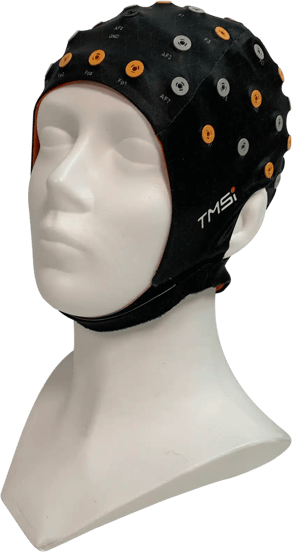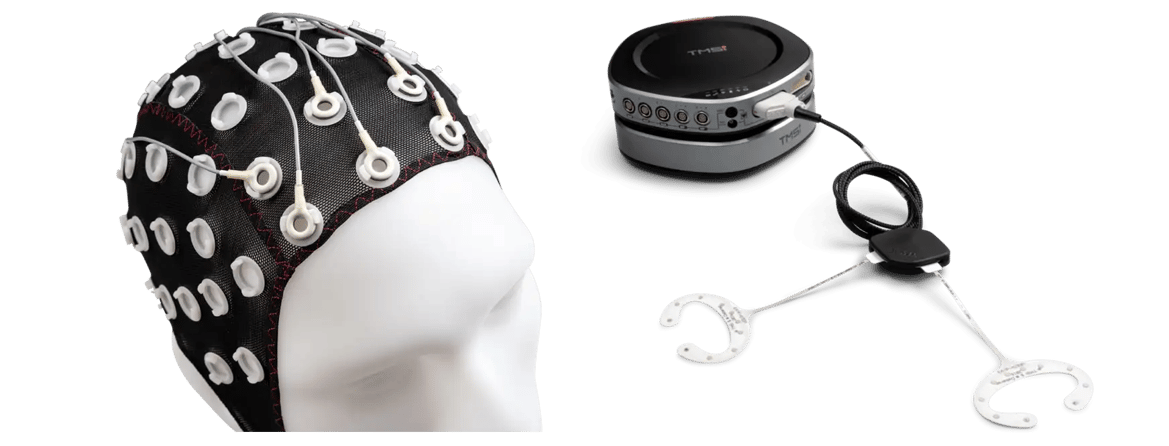What are the differences, advantages, and disadvantages?
What are the different types of EEG electrodes?
When Hans Berger first recorded EEG in 1924, he used silver foil electrodes placed on the scalp. Over the years, new technology and innovations have introduced different types of electrodes. There are several types of electrodes: gel, water, and dry electrodes.
What are gel electrodes?

The gel electrodes are the most widely used type of electrodes. They are part of routine, clinical EEG recordings and have been the gold standard in EEG research for a long time. The electrode is commonly made of silver with a coating of silver chloride (Ag/AgCl). When a gel containing many chloride ions is applied between the skin and this electrode, conduction is improved and the skin-electrode interface impedance is reduced. Therefore, the gel between the skin and electrode allows for good-quality recording of biopotentials. These gel electrodes are disc-shaped and have a hole in the middle where gel can be applied with a syringe. The preparation time of a gel EEG cap requires time as the skin needs to be abrased and all electrodes need to be filled individually by a trained technician.
Alternative gel electrode shapes
Gel electrodes can also have other shapes besides disc-shaped electrodes. For example, ring electrodes can be fitted into head caps that allow the combination of fNIRS or TMS research with EEG recordings. Moreover, alternative EEG solutions like cEEGrids also use gel to improve the skin-electrode connection/contact. These cEEGrids are placed around the ear and can be used in populations where an unobtrusive EEG solution is desired.1

Advantages of gel electrodes
- Allow for high-density EEG recordings.
- Very high signal quality.
- Less susceptible to mains interference and movement artifacts than dry and water electrodes.
- Stable recordings for a long time.
- Alternative measurement solution options (i.e. cEEGrids and ring electrodes) and can be integrated with other research equipment (i.e. fNIRS and TMS)
Disadvantages of gel electrodes
- Skin needs to be prepared by lightly scratching the skin to reduce impedance.
- Inconvenient for researchers: Preparation time can be long, the head cap requires cleaning, and drying of the cap takes time.
- Inconvenient for participants: Hair needs to be cleaned and scratching the skin can feel uncomfortable.
- Requires a skilled technician.
- Conductive gel can dry out over time during recordings over 5 hours.2
What are dry electrodes?
Dry electrodes were first studied in the 90s, and are proposed as an alternative to overcome the common issues (described above) with wet electrodes.3 Dry EEG electrodes consist of an inert conductive material that mechanically couples with the skin for signal transduction, and eliminates the need for gel or skin preparation.4 Dry electrodes are composed using various materials and shapes, such as gold-plated electrodes, bristle-type electrodes, comb-like and multi-pin electrodes, silicone conductive rubber, or foam-based sensors.5 Since dry electrodes do not use a conductive gel or abrasive paste, there is a higher electrode impedance seen with dry electrodes than with wet electrodes. Also, this can lead to poor contact noise, increased signal instability, and more sensitivity to movement artifacts.
Advantages of dry electrodes
- Quicker setup time than gel electrodes.
- Does not require skin preparation.
- Suitable for at-home testing.
- (Almost) no clean-up required.
- Possible without a trained technician in some situations.
Disadvantages of dry electrodes
- Difficulty keeping electrodes affixed onto the skin.
- Increased signal instability and higher impedances.
- More susceptible to mains interference and movement artifacts than gel electrodes.
- Limited actions are possible to improve the skin-electrode contact quality.
- Uncomfortable to the wearer.
What are water electrodes?

Advantages of water electrodes
- Quicker setup time than gel electrodes.
- Quicker clean-up than gel electrodes.
- Suitable for at-home testing.
- Possible without a trained technician in some situations.
- Overcomes problems with high impedance and signal instability seen in dry electrodes with water.
Disadvantages of water electrodes
- Dry out quicker compared to gel electrodes, so they need to be remoistened more often.7
- More susceptible to mains interference and movement artifacts than gel electrodes.
- Limited actions are possible to improve the skin-electrode contact quality.
When should you choose which electrode type?
The choice of electrode type depends on multiple factors, including desired signal quality, time constraints, availability of a trained technician, and mobility. When great signal quality is essential, the best choice is the gold standard gel electrodes. When preparation and clean-up time are critical or if there is no trained technician available, dry and water electrodes are good options. As the water electrodes are more comfortable, stable, and is less prone to artifacts, these electrodes are preferred in most situations.
At TMSi, we have gel and water-based head caps that can suit the needs of your research. These head caps, along with more information, can be found here.
References
1. Casson, A., Yates, D., Smith, S., Duncan, J. and Rodriguez-Villegas, E., 2010. Wearable Electroencephalography. IEEE Engineering in Medicine and Biology Magazine, 29(3), pp.44-56.
2.Chin-Teng Lin, Lun-De Liao, Yu-Hang Liu, I-Jan Wang, Bor-Shyh Lin and Jyh-Yeong Chang, 2011. Novel Dry Polymer Foam Electrodes for Long-Term EEG Measurement. IEEE Transactions on Biomedical Engineering, 58(5), pp.1200-1207.
3. Taheri, B., Knight, R. and Smith, R., 1994. A dry electrode for EEG recording. Electroencephalography and Clinical Neurophysiology, 90(5), pp.376-383.
4. Mota, A., Duarte, L., Rodrigues, D., Martins, A., Machado, A., Vaz, F., Fiedler, P., Haueisen, J., Nóbrega, J. and Fonseca, C., 2013. Development of a quasi-dry electrode for EEG recording. Sensors and Actuators A: Physical, 199, pp.310-317.
5. Di Flumeri, G., Aricò, P., Borghini, G., Sciaraffa, N., Di Florio, A. and Babiloni, F., 2019. The Dry Revolution: Evaluation of Three Different EEG Dry Electrode Types in Terms of Signal Spectral Features, Mental States Classification and Usability. Sensors, 19(6), p.1365.
6. Liao, L., Wang, I., Chen, S., Chang, J. and Lin, C., 2011. Design, Fabrication and Experimental Validation of a Novel Dry-Contact Sensor for Measuring Electroencephalography Signals without Skin Preparation. Sensors, 11(6), pp.5819-5834.
7. Nijholt, A., 2019. BRAIN ART. SPRINGER.

